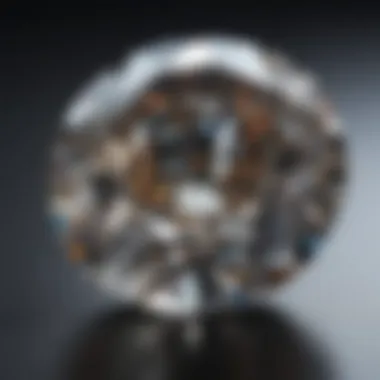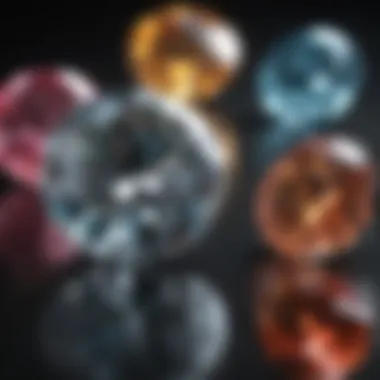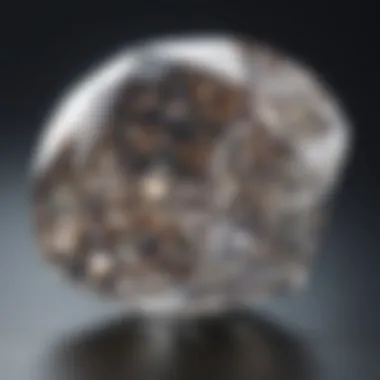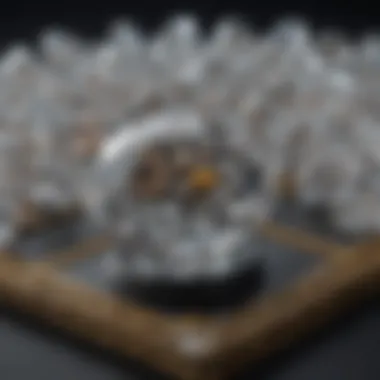Mastering Diamond Evaluation: A Complete Guide


Intro
When it comes to diamonds, many of us dream of finding the perfect stone, one that shines with brilliance and elegance. But how do you determine which diamonds are truly worth the investment? This guide will navigate the complex landscape of diamond evaluation, guiding you through the intricacies of quality assessment. Whether you are a gemstone enthusiast seeking to deepen your knowledge or a collector aiming to make an informed purchase, understanding diamonds is the key.
In the world of gemstones, diamonds are often seen as the pinnacle of luxury and beauty. Their appeal goes beyond mere aesthetics; they carry rich histories and significant values that make them unique. However, not every diamond sparkles the same way. Some catch the light in a dance of colors, while others may lack luster. Here, we will focus on the four Cs that serve as the foundation for understanding diamond quality: cut, clarity, color, and carat weight. Additionally, we'll delve into techniques for authenticating diamonds and explore ethical considerations that are increasingly becoming central to purchasing decisions.
So, let’s jump into it and start with a deeper look into the broad world of gemstones.
Foreword to Diamonds
Diamonds have long captivated humanity, not merely for their beauty, but also for the rich tapestry of history and meaning they carry. When one digs into the world of diamonds, it becomes clear that understanding them goes far beyond mere aesthetics.
Each diamond tells a story, often intertwined with notions of love, sacrifice, and even wealth. This article delves into the intricacies involved in distinguishing a high-quality diamond, shedding light on why the subject deserves attention. The depth of knowledge about diamonds enhances one's appreciation of these exquisite gems, elevating the experience of selecting or gifting jewelry.
The Importance of Quality in Diamonds
Quality plays a pivotal role when dealing with diamonds. A high-quality diamond not only appears breathtaking but can also hold and even increase its value over time. The journey to grasping what makes a diamond ‘good’ starts with understanding its characteristics, commonly summarized as the four Cs: cut, clarity, color, and carat weight. Each of these elements contributes differently to the overall experience of the diamond.
Moreover, it's essential to realize that quality diamonds often come with certifications from reputable gemological institutes. Those certifications provide reassurance about the diamond's characteristics, helping buyers make well-informed decisions. It's important to engage with a retailer who values transparency—one who is willing to guide you through the wealth of details that can influence your choice.
Not to be overlooked, personal preferences also significantly shape perceptions of quality. What might be considered top-notch for one person could differ for another, creating a rich tapestry of tastes and desires that makes the diamond-buying process unique.
Historical Significance of Diamonds
From ancient civilizations to modern times, diamonds have maintained a unique allure, steeped in myth and tradition. They were once believed to possess magical powers, used as talismans to ward off evil spirits or assure victory in battle. Indian archers in the past held diamonds as sacred, believing they could protect them from harm.
Throughout history, diamonds have also served as symbols of power and status. Royalty often adorned themselves with the most stunning stones, crafting a lineage of prestige that persists to this day. The diamond's role in engagements and wedding traditions across various cultures adds further to its historical weight. It symbolizes enduring commitment, a promise of forever etched in stone.
Today, as we reflect on the historic significance of diamonds, it's clear they are not just luxury items; they are tokens of love, bravery, and human connection. Understanding this heritage adds another layer to our appreciation and assessment of diamond quality.
Understanding the Four Cs
When diving into the world of diamonds, understanding the Four Cs is foundational to making informed purchasing decisions. The Four Cs — cut, clarity, color, and carat weight — form the bedrock of evaluating a diamond's quality. These criteria are not merely technical specifications; they play a crucial role in determining a diamond's brilliance, purity, and overall value. Without a grasp of these elements, one could very well end up with a stone that doesn’t meet their desires or expectations.
Cut: The Foundation of Brilliance
Types of Cuts
The cut of a diamond significantly influences its appearance. Different cuts—like round, princess, or pear—highlight various aspects of a diamond’s characteristics. Round cuts are often celebrated for their brilliance and fire, making them a top choice for engagement rings. Princess cuts, on the other hand, provide a modern twist with their square shape but still offer considerable sparkle. Every type of cut also has its unique feature; for instance, the elongated shape of an emerald cut can create a sophisticated look that appeals to a different set of tastes. Choosing the right cut depends on personal preference, as well as the purpose of the diamond.
Impact of Cut on Light Reflection
The interaction of light with a diamond is paramount to the brilliance perceived by the eye. The way facets are angled and aligned determines how light travels within the stone. A well-cut diamond maximizes light reflection, ensuring it sparkles just right. This phenomenon highlights why cut quality can be more important than the carat size. If the cut is poor, even the largest diamond may look dull. Therefore, aiming for a superior cut often yields more satisfaction than simply choosing size.
How to Evaluate Cut Quality
Evaluating cut quality is about more than just measuring dimensions. Tools such as a gemologist's tools or light performance evaluations are used to analyze the proportions and symmetry of a cut. Understanding this aspect may require guidance, as well-crafted diamonds can sometimes be expensive. Yet, investing in quality cut brings a rewarding sparkle, enhancing the overall aesthetic. An excellent cut, though pricey, is usually worth every penny in the long run.
Clarity: A Measure of Purity
Understanding Clarity Grading
Clarity grading assesses the presence of flaws in a diamond, whether internal imperfections known as inclusions or surface blemishes. Familiarity with the grading scale — ranging from Flawless to Included — can help in discerning quality. Knowing the distinctions can be essential since even small inclusions can affect how light is reflected, altering the diamond's appearance. A higher clarity grade means that, generally, the diamond will be cleaner and more ideally brilliant.
Identifying Inclusions and Blemishes
Inclusions and blemishes can be tricky to spot with the naked eye. A jeweler's loupe is a handy tool that helps to identify these imperfections, which can be essential for negotiation during purchases. While it's tempting to focus solely on clarity grade, remember that many inclusions are microscopic and do not affect overall beauty. They can also provide unique character to a stone, making it truly one-of-a-kind.


Common Misconceptions about Clarity
One common misconception about clarity is that any impurity automatically detracts from a diamond’s worth. While it’s true that clarity impacts value, many collectors appreciate diamonds with minor inclusions as they add uniqueness. Furthermore, some may think that clarity grading is a straightforward process; however, subjective interpretations can also play a role. Thus, it's prudent to consider expert opinions instead of relying strictly on grades from certification.
Color: Beyond the Obvious
Color Grading System
The color grading system measures the presence of color in white diamonds, with a scale from D (colorless) to Z (light yellow or brown). This aspect might initially seem straightforward, but subtle variations can significantly influence value. A D-color stone is exceptionally rare and commands a premium. Knowing the nuances of this grading helps buyers choose wisely according to their budget and preferences.
Effects of Color on Value
Color can have a profound effect on value. A diamond that is completely colorless can command much higher prices than even a near-colorless diamond. It’s worth noting that while the differences might not be stark to the untrained eye, to collectors and connoisseurs, these distinctions are apparent. Collectively, this understanding aids in spotting opportunities for acquiring quality diamonds more affordably.
Fancy Colors: A Unique Perspective
Not all diamonds have to be colorless. Fancy colored diamonds are gaining attention for their beauty and rarity. These stones are graded differently, focusing on hue, tone, and saturation. A vibrant yellow or stunning blue can carry an allure unmatched by traditional white diamonds. They serve as a reminder that exploring different colors can unveil unique collecting opportunities not typically on the radar of standard diamond buyers. However, their uniqueness can also lead to varied investment approaches since their market can be less predictable.
Carat Weight: Not Just Size
Understanding Carat Measurement
Carat is a unit that measures diamond weight, with one carat equaling 0.2 grams. However, it’s essential to note that carat weight alone does not dictate the diamond’s value. Two diamonds of equal carat weight can have vastly different values based on cut, clarity, and color. Understanding this metric helps in evaluating options more critically.
Carat vs. Perceived Size
Perceived size can differ from the actual carat weight. Factors such as the diamond’s shape and cut can affect how large it appears on the finger. For example, a well-cut round diamond might appear larger than an equally weighted square diamond. This discrepancy is crucial for buyers seeking impact without overextending their budget.
Impact of Carat Weight on Pricing
As the carat weight increases, the price tends to rise exponentially rather than linearly. While shopping, be aware that higher carats can mean you’re paying for the weight and design rather than attributes that enhance brilliance. For savvy consumers, focusing on the interplay of the Four Cs can lead to smarter purchases that deliver greater overall satisfaction.
Beyond the Four Cs
When delving into the world of diamonds, many people might fixate on the famous Four Cs: cut, clarity, color, and carat weight. However, understanding diamonds requires more than just these initial factors. Evaluating a diamond’s quality involves several additional elements that can significantly influence its value and the satisfaction of the buyer. These elements, which are often overlooked, truly round out the picture of what makes a diamond exceptional.
Certification and ethics in diamond purchasing stand out as two pivotal aspects in this expanded interpretation of value. With the possibility of counterfeit products and unethical sources, knowing how to navigate these waters is essential for anyone looking to purchase a diamond that meets their expectations both in quality and moral considerations. An informed buyer is a powerful buyer.
Certification: Ensuring Authenticity
Recognizing Reputable Gemological Institutes
The recognition of reputable gemological institutes is crucial for anyone purchasing diamonds. Such organizations, like the Gemological Institute of America (GIA) or the International Gemological Institute (IGI), provide unbiased assessments of a diamond's qualities. These institutes are known for their rigor and standards, which ensures that their grading is trustworthy.
A key characteristic of these institutes is the procedural transparency they maintain. Customers can access detailed grading reports which outline the exact characteristics, as well as the merits, flaws, and value range of each diamond. Understanding the strengths of such institutions helps buyers assure themselves that they're not being sold a bill of goods. The unique feature of these institutes is their impartiality; they serve to establish trust in the market, which can mitigate the potential for buyer's remorse in a high-stakes purchase.
Understanding Diamond Certificates
When it comes to understanding diamond certificates, they are essentially the passport of a diamond, detailing its origins and grading. Each certified diamond comes with a report that provides an array of important metrics: carat weight, clarity grade, color grade, and cut grade, among others.
These certificates serve several purposes. They not only confirm that a diamond has been evaluated by a qualified professional but also offer a potential buyer a foundational understanding of the diamond’s value. However, it’s important to recognize that not all certification is created equal; the certificate's credibility often depends on the issuing organization. Thus, discerning consumers will prioritize certificates from reputable labs.
Importance of Certification in Transactions
The importance of certification in transactions cannot be overstated. It provides peace of mind to buyers and serves as a protective layer in negotiations. In a market where price fluctuations can be as erratic as the stock market, having a certified stone can help a buyer avoid overpaying or purchasing a diamond that doesn't meet advertised standards.
A diamond's certification often acts like an official guarantee, lending confidence to the customer and instilling trust in the seller. This is particularly vital in situations where high monetary investment is involved. It’s the reassurance that the buyer isn’t merely left hanging with a sparkling rock that has dubious origins and uncertain qualities.


Ethics in Diamond Purchasing
The Conflict Diamond Issue
The conflict diamond issue—often referred to as blood diamonds—highlights an important ethical dimension in diamond purchasing. These stones are mined in war zones and sold to finance armed conflict, generating huge profits for unethical parties while contributing to suffering and human rights abuses.
Understanding this background is key for today’s conscientious consumers. Ethically aware buyers often choose retailers that can trace their diamonds to conflict-free sources, ensuring that their purchases contribute positively rather than detract from global welfare. Consequently, this heightened awareness not only affects purchasing decisions but also drives retailers to adopt responsible practices and accountability in their supply chains.
Responsible Sourcing Practices
Responsible sourcing practices have gained traction as consumers demonstrate a growing preference for ethical considerations in their purchasing decisions. This includes sourcing diamonds from certified mines that adhere to fair labor practices and environmental sustainability.
Emphasizing these practices not only serves the buyer's moral conscience but can potentially yield a diamond that carries a story worth telling. Buying responsibly sourced diamonds means directly supporting suppliers that respect both people and the planet. There’s much to gain from transparency and accountability when it comes to sourcing.
Certifying Ethical Diamonds
Certifying ethical diamonds strengthens the buyer's position in the market. This certification assures consumers that they are purchasing diamonds from sources that follow stringent ethical guidelines. Lab-grown diamonds have emerged as an attractive alternative in this realm, often receiving positive recognition for their lower environmental impact and ethical sourcing.
The main advantage of these certifications is their ability to provide documents that align with a buyer's values. It empowers consumers to make decisions that reflect their personal ethics while indulging in luxury. Furthermore, the unique feature of ethical certification helps eliminate the ambiguity that can accompany diamond purchasing, allowing for a more satisfying acquisition experience.
"A diamond is not just a stone; it's a statement of care for the world, underpinned by the integrity of its sourcing and authenticity of its qualities."
Practical Tips for Choosing a Quality Diamond
When it comes to selecting a diamond, the choices can be overwhelming. Many enthusiasts and first-time buyers often find themselves at a crossroads, unsure of how to discern the truly exceptional from the merely average. This section aims to equip you with concrete strategies that matter in the purchasing process. By honing in on practical tips, you can bypass the headaches and focus on what really elevates a diamond's allure.
What to Look for in a Retailer
Finding the right retailer is crucial. After all, you’re making an investment that could last a lifetime. A reliable retailer not only stands behind the products they sell but also helps in creating a transparent and comfortable buying experience.
Reputation and Reviews
One of the most pivotal aspects of a retailer's credibility lies in their reputation and customer reviews. A dealer with a solid standing in the community often reflects their ability to provide quality service and products. How do you gauge this?
- Look for online reviews on platforms like Yelp or Google. Genuine testimonials can highlight both strengths and weaknesses.
- Ask for referrals from friends or family who might share their experiences.
Why is reputation so vital? A reputable seller is likely to be honest about their offerings and will provide adequate post-purchase support. However, remember that reviews can sometimes be skewed. False reviews exist, so it's advisable to keep an eye out for patterns rather than isolated incidents.
Transparency in Pricing
Transparency in pricing should never be an afterthought. A good retailer will openly share their pricing structure without hidden fees popping up like unwelcome surprise guests.
This can include:
- Clearly marked price tags on items.
- Detailed breakdowns of costs, including the diamond itself, any setting, and additional fees.
The value here is two-fold: transparency fosters trust, thus making the buying process smoother. Keep a hawk’s eye for pricing transparency, as absent clarity can indicate potential overpricing or misleading discounts, which could throw a wrench in a well-informed decision.
Return Policies and Guarantees
Understanding a retailer's return policy is another critical component of ensuring a sound purchase. A solid return policy can provide peace of mind and a safety net should the diamond not meet your expectations or circumstances change.
- Look for guarantees on the quality and authenticity of the diamond.
- Inquire about the specifics for returns. Are there restocking fees? Is there a time limit for returns or exchanges?
Why pay attention to this? A clear return policy demonstrates that the retailer believes in the quality of their diamonds and respects consumer rights. Disadvantages may arise in strict policies that could limit your options post-purchase, so knowing this up front can save regrets down the line.
Using Tools for Evaluation


Once you've connected with a trustworthy retailer, it's vital to know how to evaluate your diamond properly. Several tools can assist with this.
Jeweler's Loupe
A jeweler's loupe is a small magnifying glass that allows you to examine the diamond closely. With it, you can view the intricate details such as cuts and any inclusions.
- Key feature: It typically magnifies the stone ten times.
- Benefits: Affordable and portable, making it a common choice for both enthusiasts and professionals. However, this tool can require some practice to use effectively.
Diamond Tester
A diamond tester measures the thermal conductivity of the gemstone to determine its authenticity. It’s a nifty gadget for those who might second-guess a retailer’s claims.
- Key characteristic: Quick and easy to use; results emerge in minutes.
- Benefits: Ideal for reassuring buyers about the legitimacy of their diamond. However, it doesn’t evaluate quality – merely authenticity, so combine this tool with others for a complete assessment.
Online Resources for Comparison
The digital age brings a treasure trove of resources to your fingertips. Several websites allow you to compare diamonds from the comfort of your home.
- Key feature: Side-by-side comparisons based on the Four Cs.
- Benefits: Empower you to make informed choices without any pressure, but transaction safety is crucial. Always opt for reputable sites to avoid pitfalls.
Common Mistakes to Avoid
As you maneuver through the diamond buying process, avoiding common pitfalls can make all the difference in your purchase.
Overemphasis on Carat Size
It’s easy to fixate on carat size when shopping for diamonds. While size is important, it shouldn’t be the sole consideration.
- Key characteristic: Larger diamonds come with higher prices but might compromise on cut or clarity.
- Benefits: Balancing your priorities across the Four Cs leads to overall value, rather than just size.
Neglecting Expert Opinions
In the quest for the perfect diamond, many buyers overlook the advice of gemologists or experienced jewelers.
- Key trait: Their insights can guide you toward better purchases tailored to your preferences.
- Benefits: Their expertise can save both time and money by spotting quality stones you might otherwise miss.
Falling for Unreasonable Discounts
In any market, discounts can be tempting, but too-good-to-be-true deals often are just that.
- Key aspect: Unreasonably low prices may reflect poor quality or authenticity issues.
- Benefits: Sticking to a budget is wise, but understanding that quality comes at a price will prevent regrets later on.
In diamond purchasing, always lean on informed decisions over impulsive ones. A diamond is forever, and ensuring you choose wisely pays off in the long run.
Ending: Making Informed Choices
In the complex world of diamonds, making informed choices isn't just desirable; it's essential. The value of a diamond lies not only in its physical attributes but also in the knowledge you possess about what makes those attributes stand out. This journey through the nuances of diamond quality—from understanding the Four Cs to recognizing ethical sourcing—highlights the importance of being equipped with the right information.
By understanding certification standards, you can confidently navigate the diamond market, ensuring you don’t just buy a stone, but invest in a piece that stands the test of time. The diamond industry is rife with varying prices and qualities, often leaving the uninitiated bewildered. A buyer who grasps the fundamentals is far less likely to fall prey to common pitfalls. There's an old adage: "Knowledge is power." When it comes to diamonds, this couldn't be truer.
"An educated buyer is a successful buyer."
The Value of Knowledge
Knowledge about diamonds can unlock doors that lead to both financial and sentimental rewards. Imagine stepping into a showroom, armed with an understanding of cut, clarity, color, and carat weight. You wouldn't just be a passive observer; you'd engage actively, questioning the jeweler with a discerning eye. This approach not only elevates your confidence but also significantly reduces the chances of buyer’s remorse.
In-depth knowledge allows you to make choices that match your aesthetic preferences and budget wisely. Here are some benefits of having a solid grounding in diamond knowledge:
- Empowerment in Decision Making: Knowing what to look for lets you choose wisely without relying solely on sales pitches.
- Enhanced Appreciation: When you understand the craftsmanship and grading criteria, you can fully appreciate the beauty behind the diamond.
- Avoiding Costly Mistakes: Familiarity with the market keeps you vigilant against common scams or misrepresented stones.
Final Thoughts on Diamond Quality
In closing, grasping the complexities of diamond quality is a journey well worth taking. The market may be densely populated with glittering distractions, but with a solid foundation in the essentials of evaluating diamonds, you can deftly find your way. It’s not just about flickering light; it's about understanding how each facet, each certification, each ethical consideration plays into the whole.
Considering all aspects, from the Four Cs to ethical sourcing, cultivates a holistic view of what a quality diamond embodies. Your informed choices will resonate through time, allowing you to appreciate and enjoy your gemstone for years to come. Investing in diamonds isn't simply a financial endeavor; it's a commitment to preserving beauty, artistry, and responsibility in jewelry.



